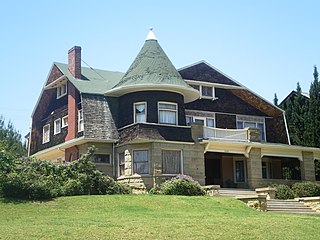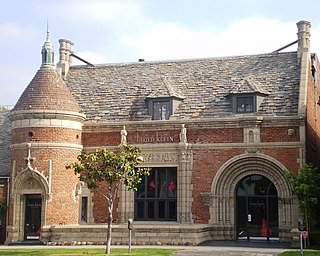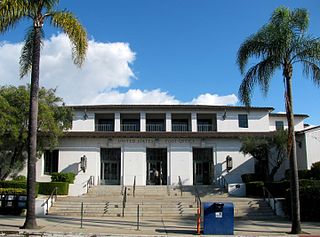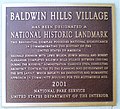
The Avery Coonley House, also known as the Coonley House or Coonley Estate was designed by architect Frank Lloyd Wright. Constructed 1908–12, this is a residential estate of several buildings built on the banks of the Des Plaines River in Riverside, Illinois, a suburb of Chicago. It is itself a National Historic Landmark and is included in another National Historic Landmark, the Riverside Historic District.

Baldwin Hills is a neighborhood within the South Los Angeles region of Los Angeles, California.
Mid-Wilshire is a neighborhood in the central region of Los Angeles, California. It is known for the Los Angeles County Museum of Art, the Petersen Automotive Museum, and the Miracle Mile shopping district.

The Pellissier Building and adjoining Wiltern Theatre is a 12-story, 155-foot (47 m) Art Deco landmark at the corner of Wilshire Boulevard and Western Avenue in Los Angeles, California. The entire complex is commonly referred to as the Wiltern Center. Clad in a blue-green glazed architectural terra-cotta tile and situated diagonal to the street corner, the complex is considered one of the finest examples of Art Deco architecture in the United States. The Wiltern building is owned privately, and the Wiltern Theatre is operated by Live Nation's Los Angeles division.

Hancock Park is a city park in the Miracle Mile section of the Mid-Wilshire neighborhood in Los Angeles, California.
Schultze & Weaver was an architecture firm established in New York City in 1921. The partners were Leonard Schultze and S. Fullerton Weaver.

Architectural Resources Group is a firm founded in 1980 by Bruce Judd and Steve Farneth in San Francisco, California. It began by providing professional services in the fields of architecture and urban planning with particular expertise in historic preservation. In 2000, David Wessel, a Principal of ARG, founded a separate conservation-contracting division, ARG Conservation Services which operates under the same roof as ARG. By 2005, the firm had expanded to a full-service architecture firm with 50+ employees. ARG also opened offices in Pasadena serving Southern California, and Portland, Oregon, serving the Pacific Northwest.

Brea City Hall Park, in Brea, California, was listed on the National Register of Historic Places in 1984.

The Wilshire Boulevard Temple, known from 1862 to 1933 as Congregation B'nai B'rith, is a Reform Jewish congregation and synagogue, located at 3663 Wilshire Boulevard, in the Wilshire Center district of Los Angeles, California, in the United States. Founded in 1862, it is the oldest Jewish congregation in Los Angeles.

Jardinette Apartments, now known as Marathon Apartments, is a four-story apartment building in Hollywood, Los Angeles, California, designed by modernist Richard Neutra. It was Neutra's first commission in the United States. In his book Key Buildings of the Twentieth Century, Richard Weston called the Jardinette Apartments "one of the first Modernist buildings in America." It has also been called "America's first multi-family, International-style building."

Alvarado Terrace Historic District is a designated historic district in the Pico-Union district of Los Angeles, California. It is located southwest of Downtown Los Angeles, along Alvarado Terrace between Pico Boulevard and Alvarado Street.

Granada Shoppes and Studios, also known as the Granada Buildings, is an imaginative, Mediterranean Revival and Spanish Colonial Revival style block-long complex consisting of four courtyard-connected structures, in Central Los Angeles, California. It was built immediately to the southeast of Lafayette Park in the Westlake District, in 1927.

The Neutra Office Building is a 4,800-square-foot (450 m2) office building in the Silver Lake section of Los Angeles, California. The building was owned and designed by Modernist architect Richard Neutra in 1950. It served as the studio and office for Neutra's architecture practice from 1950 until Neutra's death in 1970. The building has been declared a Historic Cultural Monument and listed on the National Register of Historic Places. It was listed for sale in 2007 at an asking price of $3,500,000.

El Pueblo de Los Ángeles Historical Monument, also known as Los Angeles Plaza Historic District and formerly known as El Pueblo de Los Ángeles State Historic Park, is a historic district taking in the oldest section of Los Angeles, known for many years as El Pueblo de Nuestra Señora la Reina de los Ángeles del Río de Porciúncula. The district, centered on the old plaza, was the city's center under Spanish (1781–1821), Mexican (1821–1847), and United States rule through most of the 19th century. The 44-acre park area was designated a state historic monument in 1953 and listed on the National Register of Historic Places in 1972.

The Heinsbergen Decorating Company Building, also known as the AT Heinsbergen & Company Building, is a historic building on Beverly Boulevard in Los Angeles, California, United States. It was listed on the National Register of Historic Places in 1984.

The Spring Street Courthouse, formerly the United States Court House in Downtown Los Angeles, is a Moderne style building that originally served as both a post office and a courthouse. The building was designed by Gilbert Stanley Underwood and Louis A. Simon, and construction was completed in 1940. It formerly housed federal courts but is now used by Los Angeles Superior Court.

Designed by Frank Meline and built in 1917 at the behest of J.E. Ransford, the Garden Court Apartments in Los Angeles, California was the last word in Hollywood high-style living. It had two ballrooms, a billiard room, and many suites featuring oriental carpets, oil paintings, and grand pianos. Some of the Garden Court's notable residents include Clara Bow, Louis B. Mayer, Carl Laemmle, Mack Sennett, Stan Laurel, John Gilbert, and Mae Murray.

Reginald Davis Johnson (1882–1952) was an American architect. His practice, based in Pasadena, California, focused on the Los Angeles area and southern California in general, with a mixture of residential and commercial work. Johnson's later work was influenced by his progressive ideas on housing policy.
Villa Carlotta is the name of two landmark buildings in greater Los Angeles, California.























